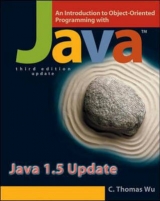
Introduction to Object-Oriented Programming
Seiten
2003
|
3rd Revised edition
McGraw-Hill Inc.,US (Verlag)
978-0-07-292195-3 (ISBN)
McGraw-Hill Inc.,US (Verlag)
978-0-07-292195-3 (ISBN)
- Titel erscheint in neuer Auflage
- Artikel merken
Zu diesem Artikel existiert eine Nachauflage
Provides an introduction to the basics of programming in java. This title emphasises on object-oriented programming. The larger sample development programs are included, giving students an opportunity to walk through program design, learning the fundamentals of software engineering. Its visual approach assists students in understanding concepts.
"An Introduction to Object-Oriented Programming with Java" provides an accessible and thorough introduction to the basics of programming in java. This much-anticipated revision continues its emphasis on object-oriented programming. Objects are used early so students begin thinking in an object-oriented way, then later Wu teaches students to define their own classes. In the third edition, the author has eliminated the author-written classes, so students get accustomed to using the standard java libraries. Also, new is the use of smaller complete code examples to enhance student learning. The larger sample development programs are continued in this edition, giving students an opportunity to walk incrementally walk through program design, learning the fundamentals of software engineering. The number and variety of examples makes this a student-friendly text that teaches by showing. Object diagrams continue to be an important element of Wu's approach. The consistent, visual approach assists students in understanding concepts.
"An Introduction to Object-Oriented Programming with Java" provides an accessible and thorough introduction to the basics of programming in java. This much-anticipated revision continues its emphasis on object-oriented programming. Objects are used early so students begin thinking in an object-oriented way, then later Wu teaches students to define their own classes. In the third edition, the author has eliminated the author-written classes, so students get accustomed to using the standard java libraries. Also, new is the use of smaller complete code examples to enhance student learning. The larger sample development programs are continued in this edition, giving students an opportunity to walk incrementally walk through program design, learning the fundamentals of software engineering. The number and variety of examples makes this a student-friendly text that teaches by showing. Object diagrams continue to be an important element of Wu's approach. The consistent, visual approach assists students in understanding concepts.
0 Introduction to Computers and Programming Languages 1 Introduction to Object-Oriented Programming and Software Development 2 Getting Started with Java 3 Numerical Data 4 Defining Your Own Classes 5 Selection Statements 6 Repetition Statements 7 Event-Driven Programming and Basic GUI Objects 8 Exceptions and Assertions 9 Characters and Strings 10 Arrays 11 Sorting and Searching 12 File Input and Output 13 Inheritance and Polymorphism 14 Advanced GUI 15 Recursive Algorithms Appendix A How to Run Java Programs Appendix B Sample Programs Appendix C Standard Classes and Interforces Appendix D UML Diagrams
| Erscheint lt. Verlag | 23.6.2003 |
|---|---|
| Verlagsort | New York |
| Sprache | englisch |
| Maße | 190 x 231 mm |
| Gewicht | 1458 g |
| Themenwelt | Informatik ► Office Programme ► Outlook |
| ISBN-10 | 0-07-292195-1 / 0072921951 |
| ISBN-13 | 978-0-07-292195-3 / 9780072921953 |
| Zustand | Neuware |
| Haben Sie eine Frage zum Produkt? |
Mehr entdecken
aus dem Bereich
aus dem Bereich
Buch | Softcover (2022)
Markt + Technik Verlag
14,95 €
Band 1: Grundlagen des digitalen Zeitalters
Buch | Softcover (2024)
Springer Gabler (Verlag)
49,99 €



